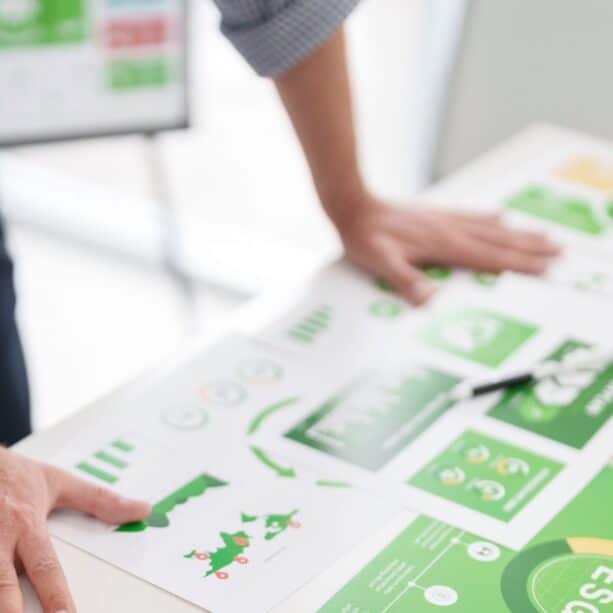Beyond the Digital Frontier: How Smart Procurement Can Build a Circular Economy for Tech
Author: Diego Bermudez, PhD
The digital revolution, powered by AI, cloud computing, and countless devices, has transformed our world. But this progress comes with a hidden cost: a massive environmental footprint. From the energy-hungry data centres training AI models to the mountains of electronic waste (e-waste) we generate, our current digital ecosystem operates on an unsustainable “take, make, dispose” model.
To build a truly sustainable digital future, we must shift our thinking from a linear to a circular economy. This means designing systems where resources are used efficiently, products are built to last, and waste is eliminated. A powerful, yet often overlooked, tool to drive this change is procurement. By setting clear sustainability standards for the technology we buy, we can reshape the entire market.
The UK Government is already paving the way with its Government Buying Standards (GBS), a prime example of how purchasing power can be leveraged to embed circularity into our digital infrastructure.

The Big Picture: Why Circularity in Tech Matters
At its core, the push for circularity is about aligning our technological ambitions with the well-being of our planet and society. This concept is perfectly captured by the Triple Bottom Line (TBL) framework, which evaluates performance based on three pillars: social, environmental, and financial impacts. Circularity ensures that economic drivers don’t overshadow critical environmental and social needs.
AI and other digital technologies have a significant environmental impact, from the vast energy consumption of data centres to the resource depletion associated with manufacturing hardware. A circular approach addresses this by promoting:
Resource Efficiency: Minimising the use of new materials and energy.
Longevity and Reusability: Designing hardware for longer lifespans and making it easy to reuse or refurbish components.
Waste Reduction: Minimising e-waste and optimising data storage to reduce energy demand.
Powering the Cloud: Circularity in Data Centres and AI
Data centres are the backbone of the digital world, but they are also major consumers of energy and water. To tackle this, we need a multi-layered approach that addresses both the facility’s operation and the hardware within it.
Several standards offer a roadmap. The EU’s Code of Conduct on Data Centre Energy Efficiency focuses on operational circularity—improving management practices to maximise the life and efficiency of existing infrastructure.
In contrast, certifications like EPEAT and TCO Certified focus on product circularity. They aren’t for the building itself but for the IT equipment (servers, storage) inside.
EPEAT is a global ecolabel that rates electronics on lifecycle criteria like materials selection, energy efficiency, and end-of-life management.
TCO Certified is even more comprehensive, adding social responsibility in the supply chain to its environmental criteria. It has a strong focus on circularity, with specific requirements for product repairability and upgradability.
For the GBS to be effective, it should adopt a flexible, performance-based strategy that encourages market readiness. This means focusing on:
Performance-Based Requirements: Setting and reporting on key metrics like Power Usage Effectiveness (PUE), Water Usage Effectiveness (WUE), and Carbon Usage Effectiveness (CUE).
Energy Efficiency: Aiming for 100% renewable energy use and targeting at least 25% waste heat reuse, a model being implemented in Germany.
Water Efficiency: Avoiding construction in water-stressed regions or transitioning to water-free cooling technologies.
Hardware Circularity: Establishing clear targets for zero waste to landfill and implementing programs for product reuse, refurbishment, and responsible recycling.

The Tools of Our Trade: Sustainable ICT Hardware
For the ICT hardware we use every day, a circular economy means moving away from disposable devices toward products designed for longevity. The government can drive this change by integrating best practices & standards into its procurement policies.
A truly ambitious step would be to set a target for second-life components. A practical and impactful goal would be for 30% of all ICT hardware components by volume to be sourced from reused, refurbished, or remanufactured materials.
This target is ambitious enough to push suppliers toward circular design but realistic enough to be achievable. To make it work, the government should implement it with a clear, phased approach:
Start with a Lower Baseline: Begin with a 10% target in the first year, increasing to 30% over a 3- to 5-year period while conducting a market readiness assessment among its suppliers to inform the transition.
Focus on Key Components: Prioritise high-impact components like RAM, SSDs, CPUs, and chassis materials.
Incorporate it into Procurement: Make the target a mandatory requirement in government contracts to link sustainability directly to business outcomes.
Address Trade-offs: Prioritise the replaceability of components like batteries, which degrade quickly, over simple longevity. This keeps valuable materials in circulation.
Support the Market: A government-level platform for second-hand components could create a robust marketplace for circular services, enabling reuse at a larger scale.
Hardware is only half the story. Software plays a critical, often invisible, role in the circular economy. Planned obsolescence, where devices become unusable because they can no longer receive software updates, is a major driver of e-waste.
To achieve true circularity, we need a holistic software strategy that combines two key approaches, exemplified by certifications like Blue Angel and the Green Software Design Certificate:
Physical Circularity (The Blue Angel approach): Software must be designed to not cause hardware obsolescence. This means ensuring it can run on older hardware and extending its support life.
Operational Circularity (The Green Software Design approach): Software must be resource-efficient to reduce the energy and carbon footprint of its active use.

A comprehensive strategy for software circularity should include:
Sustainable Design: Developers must optimise the energy and computational demands of software from the initial design phase, with continuous tracking and reporting.
Hardware Longevity: A long minimum support period for software should be established, aligned with hardware longevity targets. Promoting a modular, open-source approach can also help extend a device’s functional lifespan.
Secure End-of-Life Management: When hardware is retired, robust and secure methods for erasing private data must be available. This is essential for encouraging the safe reuse and recycling of devices.

A Call to Action
Embedding circularity into our digital infrastructure is not just an environmental necessity; it’s an economic and social imperative. By strategically using procurement standards, the UK government can send a powerful signal to the market, driving innovation and fostering a new generation of sustainable technology. This is a complex, system-wide effort that requires collaboration between government, industry, and suppliers. But by starting with what we buy, we can build a digital world that is not only smart but also sustainable.
Would you like to continue this conversation? Get in touch.

